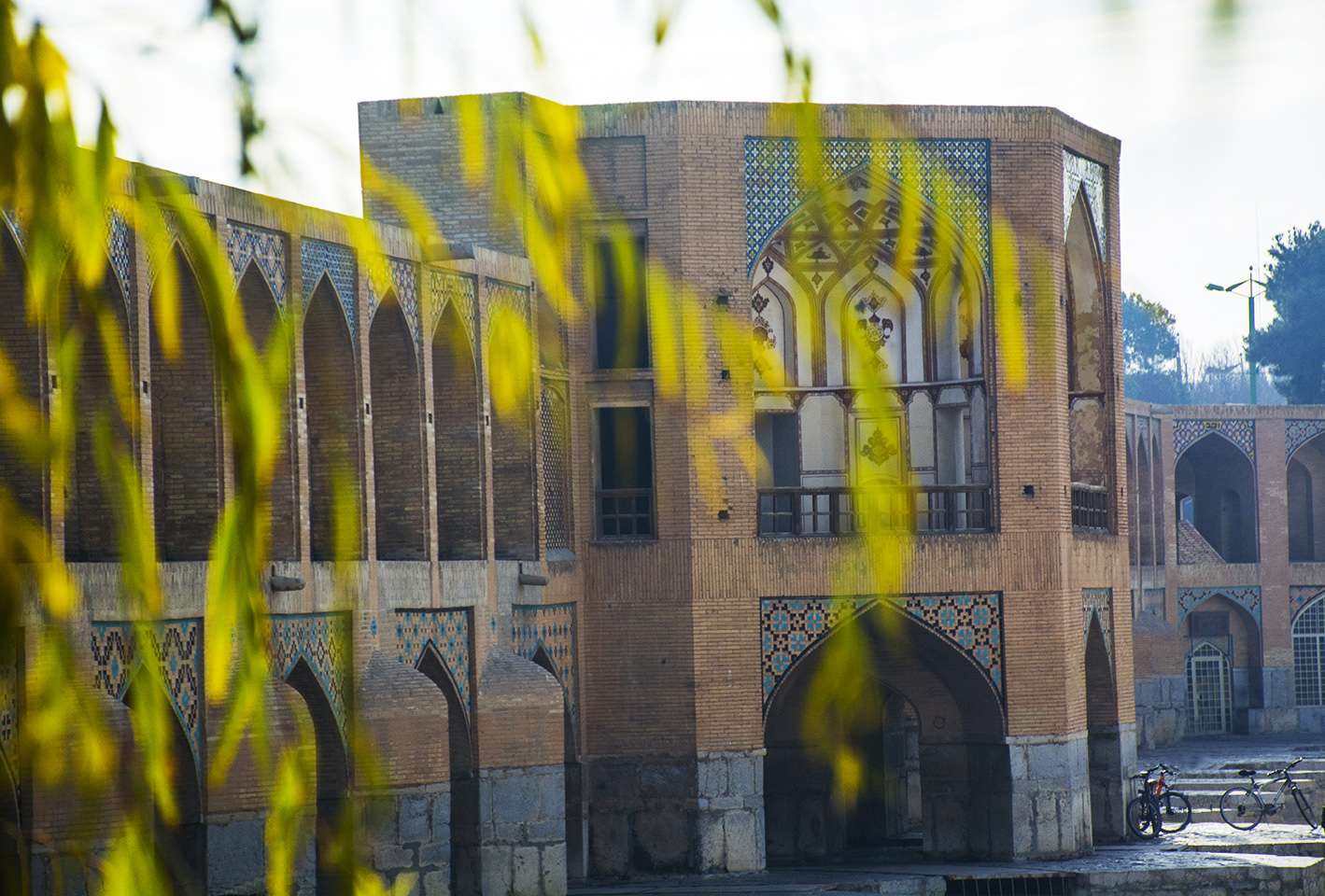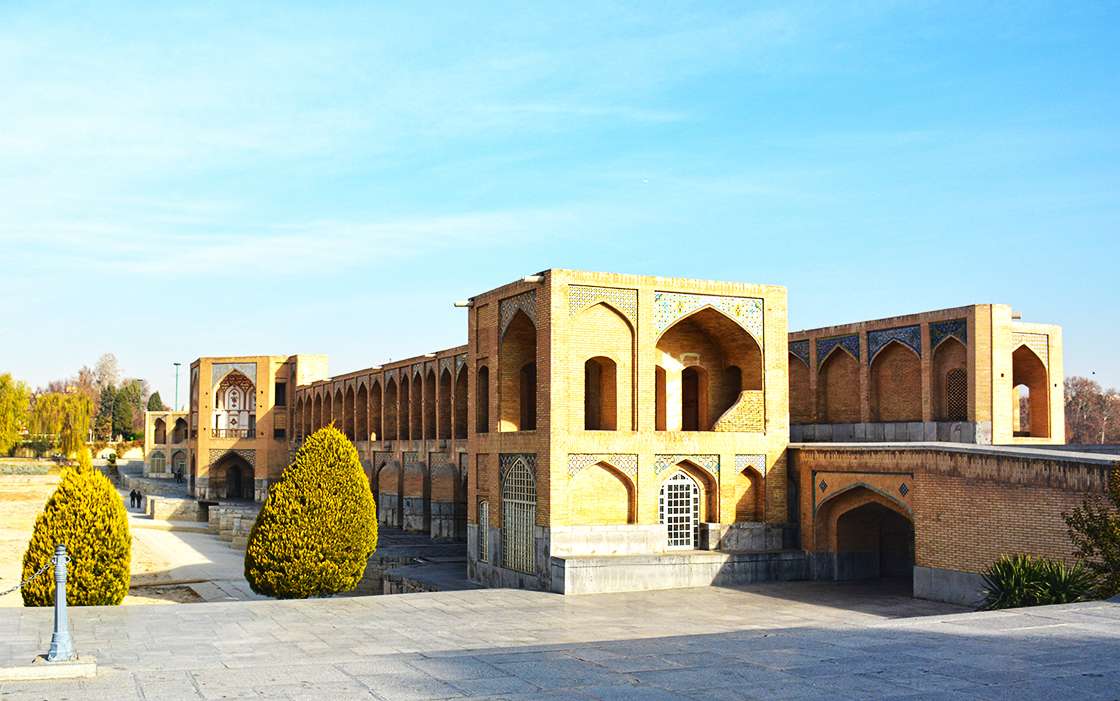Khaju Bridge, located in Isfahan was built in 1650 by the order of Shah Abbas II. It is one of the most beautiful bridges of Isfahan and Iran. Want to listen to the gurgle of water and Iranian singing at the same time, while enjoying the view? Then, Khaju bridge of Isfahan is a must-see for you.
Isfahan
Isfahan is famous for the beautiful Zayande Rud river passing through the city. Even though the river’s water has reduced considerably during the past few years, it has been the lifeblood of this city. In addition to adding to making Isfahan more beautiful, the river has been a reason why some of the most interesting historical structures of Isfahan have been created.
Several bridges have been built across the river. While the older historical bridges have been maintained, newer ones have also been made for cars and vehicles. The oldest bridge in Isfahan dates back to the Sassanid era. Of course, it has been renovated many times throughout the years.
The History of Khaju Bridge
Bridge in Isfahan was constructed in 1650, where there used to be another older bridge from the Timurid period. Shah Abbas II ordered this construction. Because of its closeness to a neighborhood of the city where the houses of khajes (courtiers) were located, the bridge was called Khaju.

The Amazing Features of Khaju Bridge
Unlike other bridges, Khaju bridge has a pavilion built in its center, together with 2 chambers at either side. In the pavilion, you can still see the remains of the shah’s stone seat. You can see beautiful colored tiles decorating the walls of this pavilion and the entire bridge.
Another amazing feature of the Khaju Bridge is the sluice gates installed under the lower arches of the bridge. These have the ability to control the inpour and outpour of water through the bridge. This was mainly intended to block or limit the passage of water. It helped to increase the level of water trapped behind the bridge. This water was used for irrigating the nearby gardens.
In addition to all these features, what makes the bridge more interesting, specially at nights, is the fact that the locals gather near the bridge and sing. During the seasons when the Zayanderud River is dry, most arches of the lower passageway become venues for local singers and their audience who more often than not sing along.
Architecture of Khaju Bridge
The amazing architecture of Khaju Bridge has attracted so many tourists so far. It is a 12 meters wide and 133 meters long structure, made by bricks and stones. The bridge has been built in 2 floors: horse riders, carts, and caravans took the top floor in order to cross the river, while pedestrians used the passageways on the sides as well as the bottom floor. The row in the bottom consists of 23 arches. The bridge also includes 3 chambers: 1 in the middle which served as a pavilion for the royal family, 2 at the sides which worked as tea houses.

The Beauties of the Bridge
The chambers in the center of the bridge were used by Shah Abbas II for recreation and passing time. The bridge provides an amazing view of the river as well as the horizon. Viewing the sunset over the city is a pleasure enjoyed by locals even to this date. Besides, beautiful tiles and paintings can be found here and there, reminiscing the past glory of the bridge.
In addition to this, visiting the bridge at night will reveal its charming beauty engulfed in lights. There are two stone statues of lions on two sides of the bridge. Nothing seems strange about these lions at first sight. But we recommend you to approach one of these lions and look straight into the other one. You’ll see that the eyes of the other lion is shining with a green light. At night, you will also hear the sound of groups of people who gather in the archways and sing.
Khaju Bridge Address
You can find Khaju Bridge by following these addresses:
• Khaju Bridge, Kamal Esmaeel Street, Isfahan, Esfahan, Iran
• Khaju Bridge, Ayine Khaneh Boulevard, Isfahan, Esfahan, Iran
Khaju Bridge opening hours
Khaju bridge is open every day and you can visit it whenever you want. In the morning, you will be able to see the amazing architectural and artistic features of the bridge. As the evening falls, the bridge is illuminated with charming lights.
Khaju Bridge Entrance Fee
As Khaju Bridge is a public place, you don’t need to purchase a ticket or pay an entrance fee.

FAQ
Khaju Bridge is a public place. So, you can visit the bridge whenever you want. In the morning, you will be able to see the bridge’s details better. But at night, the lights add a sense of mysterious beauty to the place.
You will be able to find a number of hotels near Khaju Bridge, to name a few:
• Khaju Hotel
• Zohre Hotel
• Parsian Suite Hotel
• Parsian Kowsar Hotel
• Abbasi Hotel
• Sepahan Hotel
• Ghasr Monshi Hotel
• Mahbibi Hotel
• Safavi Hotel
• Parsian Ali Qapu Hotel
Nearby Khaju Bridge, you can find a variety of restaurants and cafes:
• Farang café
• Milan restaurant
• Nikan restaurant
• Azam biryani
• Lotus café restaurant
• Le Vant café and restaurant
• Abbasi Restaurant
• Sequence café and restaurant
Besides being one of the beautiful tourist attractions of Isfahan, the location of Khaju Bridge is quite close to a number of Isfahan’s top attractions. The closest sights are:
• Chooni Bridge
• Si-o-se Pol Bridge
• Vank Cathedral
• Bethlehem Church
• Chaharbagh Promenade
In addition to this, from the bridge you can easily access the following attractions:
• Hasht Behesht Palace
• Chehel Sotun Palace
• Naqsh-e Jahan Square
Khaju Bridge is one of the historical bridges of Isfahan. It was built in the 17th century and consists of 2 floors. The top floor was mainly used by caravans, while pedestrians could use the narrow passages on the sides. However, the bottom floor was used by pedestrians.
In addition to this, the Safavid kings also used to visit the bridge, enjoy the beautiful nature and even hold meetings. All of these happened at the pavilion in the middle of the bridge.
You can enter the bridge and walk across it without paying an entrance fee. This is considered a public place which you can visit whenever you want, without purchasing a ticket.



Comment (0)